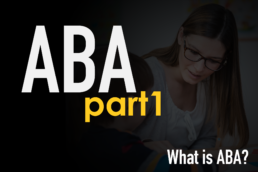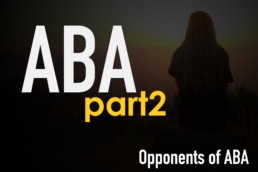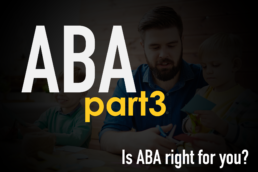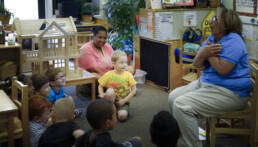Applied Behavior Analysis (part 1 of 3) – What is ABA?
Applied Behavior Analysis (part 1 of 3) – What is ABA?
So. ABA.
When Jonah was diagnosed with Autism in December 2016, the diagnosing physician from a prestigious medical program recommended 2 things going forward.
- An extended day program specifically for autistic learners and
- Applied Behavior Analysis (ABA)
Now the first thing recommended (extended day program) is something that many school districts offer here in the US, specifically for children with autism. We are fortunate enough to live close to a school that offers this program. We just needed a diagnosis to get in…
The second thing (ABA) was completely new to me. I had no idea what it was. We were given a packet of papers with numerous websites and ABA centers, most with huge waiting lists months and years long.
I had many of the same questions you have now. What exactly IS ABA? Why is it recommended and what can we expect the therapy sessions to look like? Is it even a therapy session? How long does our child need to do it? How often? What results should I expect from it?
After months of research I want to share with you what I’ve found.
I had originally intended to write a blog post about it, but there is so much to unpack, I decided to do a blog series on it. It will be broken down into 3 parts.
So this will be the first installment.
*disclaimer I am in no way promoting or discouraging the practice or implementation of ABA. My aim is simply to pass along what I have learned in order for you to make your own informed decision regarding what therapy is right for you.
According to the Centers for Disease Control and Prevention (CDC) Autism rates in the United States are now 1 in 44 children, as of 2021. ABA and similar therapies are now the leading method of “treating” all those with Autism in the US. The majority of the medical and psychiatric field are recommending it on a daily basis to thousands upon thousands of parents and caregivers.
I’ve pieced together a detailed summary of what ABA is according to different web sites which you can read below but the TL;DR (Too Long; Didn’t Read) of it is that ABA is an extended reward/consequence based behavioral intervention therapy specifically geared toward people with autism, encouraging “proper” behavior, and discouraging other behaviors.
It’s an approach that was derived from learning theory. In ABA, a socially significant behavior is targeted, such as a child learning to make a request. And then an environmental alteration is introduced, such as teaching instructions and a reward for a correct response. And then the change in the targeted behavior is objectively measured.
Sessions can be 2 to 3 hours long, consisting of short periods of structured time devoted to a task, usually lasting 3 to 5 minutes. 10 to 15 minute breaks are often taken at the end of every hour. Free play and breaks are used for incidental teaching or practicing skills in new environments. Done correctly, ABA intervention for autism is not a “one size fits all” approach consisting of a “canned” set of programs or drills. On the contrary, every aspect of intervention is customized to each learner’s skills, needs, interests, preferences, and family situation. For those reasons, an ABA program for one learner might look somewhat different than a program for another learner. An ABA program will also change as the needs and functioning of the learner change. The recommended frequency for ABA is 25-40 hours per week of therapy.
This from Autism Speaks
Behavior analysis focuses on the principles that explain how learning takes place. Positive reinforcement is one such principle. When a behavior is followed by some sort of reward, the behavior is more likely to be repeated. Through decades of research, the field of behavior analysis has developed many techniques for increasing useful behaviors and reducing those that may cause harm or interfere with learning.
Applied behavior analysis (ABA) is the use of these techniques and principles to bring about meaningful and positive change in behavior.
Behavior analysts began working with young children with autism and related disorders in the 1960s. Early techniques often involved adults directing most of the instruction. Some allowed the child to take the lead. Since that time, a wide variety of ABA techniques have been developed for building useful skills in learners with autism – from toddlers through adulthood.
These techniques can be used in structured situations such as a classroom lesson as well as in “everyday” situations such as family dinnertime or the neighborhood playground. Some ABA therapy sessions involve one-on-one interaction between the behavior analyst and the participant. Group instruction can likewise prove useful.
ABA principles and techniques can foster basic skills such as looking, listening and imitating, as well as complex skills such as reading, conversing and understanding another person’s perspective.“
The overriding goal is to extend scientific principles of human behavior beyond highly-controlled or laboratory environments to resolve real life problems. The key features of ABA are, of course, that it is applied, behavioral, and analytic.
Applied means that interventions are geared toward achieving socially-important goals, helping people be more successful in natural settings such as homes, schools, and communities. Behavioral means that ABA focuses on what people say or do, rather than interpretations or assumptions about behavior. And analytic means that assessments are used to identify relationships between behavior and aspects of the environment (e.g., screaming occurs most when “Timmy” is given a difficult task and allows him to delay or avoid that activity) before proceeding to intervention.
In addition to these basic characteristics, behavior analytic interventions are expected to be defined clearly so they can be used consistently and to only include behavioral strategies that are sound in both theory and in practice. ABA involves ongoing data collection to evaluate whether behavior is changing in the desired direction and the goals are being achieved. The expectation is that outcomes ‘generalize’ across people, situations, and settings and continue over time.
How is ABA used?
Over the years, a variety of practices have evolved out of ABA. These practices are based on something called the “three-term contingency” – antecedents-behavior-consequences. In essence this means that behavior occurs in response to events or conditions in the environment (i.e., antecedents) and continues due to its results (i.e., consequences). For example, a child may whine when asked to do a lengthy or difficult chore and that whining may result in delaying its completion as the parent cajoles the child to finish.
ABA practices typically involve the following elements:
- Managing the consequences of behavior by rewarding positive behavior, withholding positive consequences, or – in some cases – using punishment (e.g., scolding) to deter behavior
- Re-arranging antecedents to promote positive behavior and minimize the likelihood of problem behavior (e.g., clarifying expectations, simplifying tasks, providing choices)
- Teaching skills that allow individuals to be more successful and less reliant on problem behavior to meet their needs
Prompts are cues or assistance to encourage the student to provide the desired response. There are many natural prompts in the environment, for example, seeing the school bus arrive, hearing a bell ring, or noticing that students are lining up at the door.
Prompts can be:
- Direct (“Put your books on the shelf in the locker”) or indirect (“Where do books need to go?”);
- Verbal, physical, or visual (gestures or pictures);
- Brief (to get the student started on a task) or intensive (step-by-step through the task).
Some students have difficulty recognizing, understanding, or responding to some prompts. It is important to determine the type and intensity of prompting that the individual student requires. Students can become dependent on prompts from others, so it is important to plan for the fading of prompts when appropriate. Visual supports can provide a method of prompting that many students can learn to use independently. The goal is to help the student become as independent as possible in participating in and completing tasks.
A form of prompting is modelling. It provides a visual example of what is expected in a task by having students see the task being performed. It can also help the student see the sequence of steps in the task. For example, the student learns the actions to a song by first watching a demonstration by an adult.
The target behaviour is encouraged through the use of reinforcement. Reinforcement is provided after the target behaviour to increase the likelihood that the behaviour will reoccur.
Reinforcers can be:
- Tangible (such as stickers);
- Activity-based (the student is able to participate in preferred activity);
- Social (praise or thumbs up sign).
Reinforcement can be provided for displaying positive behaviours to encourage these behaviours to continue, or for refraining from or reducing the occurrence of negative behaviours. It can be something provided (such as praise) or something removed (such as a non-preferred activity being removed when the student asks appropriately).
Reinforcements must be motivating to the individual student. What motivates one student may not motivate another. Similarly what is motivating to an individual student may change over time. It is important that monitoring be used to ensure that the reinforcer remains effective. In some cases, developing a “Menu” of reinforcers may be helpful so that students may select from several options.
To encourage students to be as independent as possible, it is important to gradually change reinforcers from others to more natural reinforcers, such as the satisfaction of completing a task.
Task analysis involves breaking tasks down into smaller, teachable steps. Here, the goals for each step are established, and task performance can then be taught according to these steps. Each subtask is taught and reinforced in sequence. In many cases, students may have difficulty only with one step within the larger task, rather than with the task overall. It is important to write subtasks in terms of what the student will do, and to record interventions or prompting that are required for students to complete the subtasks.
When steps within a task are identified through task analysis, use forward chaining to focus instruction to teach the first step or subtask that the student has not mastered, and then assist the student with the rest of the task. Once the student masters the first subtask, then focus instruction on the next step that the student has not mastered, continuing until the student can complete all of the subtasks. For example, in learning to print his or her name, focus the student on learning to print the first letter and print the rest of the letters for the student.
In backward chaining, it is the last step or subtask that a student has not mastered that is focused on first. This provides the student with immediate reinforcement through successful completion of the task. Once this skill is mastered, the focus moves to the next-to-last subtask. For example, a student learning to remove outdoor clothing might initially focus on learning to hang his or her coat on a coat hook after being assisted with other steps. Next, the student would learn to take off his or her coat, and then hang it on the hook.
Like task analysis, Discrete Trial Training (DTT) involves analysing skills and breaking large tasks into steps or subtasks (or discrete skills). Here, subtasks are usually taught sequentially, and each subtask is mastered before learning the next skill. DTT consists of four steps:
Step 1: The student is given a brief instruction or question (stimulus) that is designed to produce a specific response. If necessary, the instruction is followed by a prompt.
Step 2: The student responds.
Step 3: If the response is as expected, the student receives reinforcement such as praise.
If the response is not as expected, the response is ignored or corrected or the student is prompted to provide the expected response.
Step 4: Data are recorded. Subsequent trials or instructions are then given.
Shaping involves the use of reinforcements to change behaviour gradually and systematically. Here, approximations of the desired behaviour are reinforced until the target behaviour is achieved. For example, these steps could be followed if the target behaviour is for the student to sit with a group during story-time:
Step 1: Reinforcement for standing near the group.
Step 2: Reinforcement for standing closer to the group.
Step 3: Reinforcement for standing in the group.
Step 4: Reinforcement for sitting in the group.
So that is an overview of ABA
The ultimate goal of ABA is to establish and enhance socially important behaviors. Such behaviors can include academic, social, communication, and daily living skills; essentially, any skill that will enhance the independence and/or quality of life for the individual.
Next: How can ABA be viewed as a “bad” thing?
You would be surprised. Many parents and caregivers are simply told to “Do ABA” with their children and aren’t told about the possibility of harmful experiences for their child. The most vocally AGAINST the practice of ABA are autistic adults, many of whom have been through some form of ABA themselves.
My next blog will explore this opposition to ABA and why those opposed think it is a harmful thing. Stay tuned!











